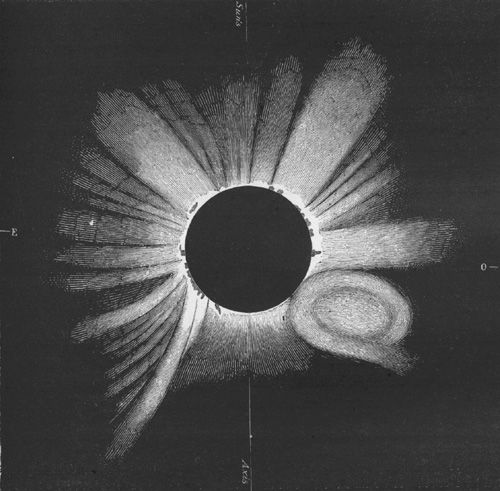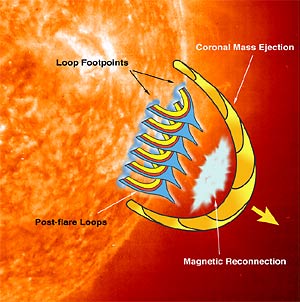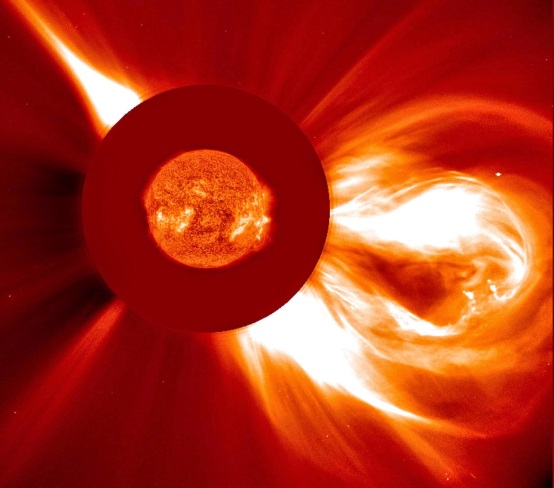Coronal Mass Ejections
There are many features of the sun that will likely be seen during the total solar eclipse including the spectacular corona, helmet streamers, the thin red ring of the chromosphere, and perhaps a few prominences. Previous essays have discussed these features and what they represent, but there is one additional feature that may be seen under rare conditions: Coronal Mass Ejections. From time to time, the sun hurls billion-ton clouds of plasma into interplanetary space in a dramatic eruption lasting several hours. Among the many dozens of images of past total solar eclipses both photographic and hand-drawn, only one example may exist of such an event actually seen during totality.
During the July 18, 1860 eclipse, Gugliemo Temple drew this curious rendition of what he saw. It showed the ‘usual’ coronal streamers and numerous prominences dotting the limb of the eclipsed sun. But in the lower right quadrant he also saw a curious circular feature not unlike what modern space observatories such as the Solar and Heliospheric Observatory (SOHO) have routinely imaged since the 1990s. Contemporary interpretations of this drawing support the idea that this was, in fact, a CME. Moreover, 1860 was near the peak of sunspot cycle 10 during which time CME events typically occur every few days.
Strange eruptions of matter from the sun had already been observed indirectly since the 1940s. From time to time, bursts of radio-wavelength energy would be observed from the sun. These were monitored at many wavelengths and classified by type and duration. The most curious of these were the traveling Type IV radio bursts detected in the 1950s. It was known through their radio properties that these events were caused by clouds that were a combination of magnetic fields and plasma emitting at radio frequencies, and traveling at over 1000 km/sec. By the 1960s, these solar eruptions were detected via the shock waves they produced, which could be detected by interplanetary spacecraft, and in their interaction with Earth’s magnetic field causing magnetic storms.
The relationship between Type IV clouds and other optical features of the sun could not be studied until the first generations of coronagraphs were deployed in the early-1970s. The first white-light observation of a coronal transient was on August 11–12, 1970, and reported by astronomer Shirley Hansen at the ground-based, Mauna Loa Coronal Activity Monitor. A coronal streamer structure above the sun’s east limb had suddenly disappeared, and was accompanied by Type II and Type IV bursts. The NRL White Light Coronagraph on the OSO-7 spacecraft also observed a coronal transient event in 1972, which was photographed by NRL electronics technician David Roberts, and identified by solar physicist Richard Tousey. Numerous additional events were observed on Skylab (1974), on the NRL, P78-1 ‘Solwind’ spacecraft (1980), the Solar Maximum Mission (1980) and with the LASCO instrument onboard the Solar and Heliospheric Observatory (1995). The term ‘coronal mass ejection’ came into common usage by 1982 to describe these large radio and optical mass ejection events from the solar corona.
So, what are they?
At much smaller scales, solar prominences seen in the chromosphere are magnetic loops that contain millions of tons of cool gas that can remain stable for hours, or suddenly erupt. They form above sunspot regions and are easily observed at optical wavelengths. Even during total solar eclipses, they look like small red flames hugging the darkened disk of the moon, and have been observed for centuries with the naked eye. Coronal mass ejections are related to solar prominences, but at a much larger scale.
Magnetic fields on the sun start out as small loops of magnetism, but through the process of reconnection, they can collide and reconnect into much larger structures. They may start out as the 10,000-km loops that connect sunspots, but can grow into loops that span many sunspot groups forming the prominences, or even larger loops that extend into the corona and span nearly the full million-kilometer diameter of the sun itself! As they grow, the plasma they contain also increases in mass until some reach the scale of billion-ton clouds. We think that when these loops and matter are stable they resemble the coronal helmet streamers seen during a total solar eclipse, but something happens to upset the delicate pressure balances between the loop’s magnetic field and plasma, and the surrounding coronal plasma. The loop becomes unstable and erupts, launching its plasma and its magnetic field into interplanetary space like a helium balloon released during a birthday party. This image shows one such process for creating a CME developed by researchers with the NASA/RHESSI spacecraft.
Although the exact details for CME ejection are not known, they often occur above a major solar flare event or the eruption of a prominence. This suggests that the overlying CME magnetic field is in a stable state, and that a large impulsive event below it is enough to destabilize it and cause the ejection. Typically at radio wavelengths, this triggering event is seen as a Type-II radio burst at high frequencies, followed by a traveling Type-IV burst that is produced by the CME itself as it leaves the corona. Some of the most beautiful CMEs have been images by the SOHO, LASCO coronagraph (e.g. December 2, 2003, credit ESA/NASA/SOHO) since the 1990s. Movies of these events have led to enormous improvement in our understanding of how they are produced and formed.
One representation of a CME reveals a loop of twisted magnetic field in which plasma is trapped. This loop produces a shock wave in front of it within the interplanetary medium. Inside the loop, the density of the interplanetary medium is very low because the CME has ‘snow plowed’ this material into the shock front ahead of it. When the CME magnetic field is oriented the same way as Earth’s magnetic field, the CME produced a weak disturbance in Earth’s field. But when the CME field is opposite in polarity, it can produce a major magnetic storm and spectacular aurora. As the CME erupts from the corona where plasma densities are highest, it creates a powerful shock front that accelerates some particles, mostly protons, to nearly the speed of light. These bursts of high-energy protons can reach Earth in less than an hour and are observed as Solar Proton Events. ‘SPEs’ can have deadly consequences for humans and technology not properly shielded.
Although the sun is nearing sunspot minimum and few CMEs are being produced every month, as you admire the sun’s beautiful corona, keep an eye out for an unusual circular feature that may be one of those rare CMEs about to be launched!









